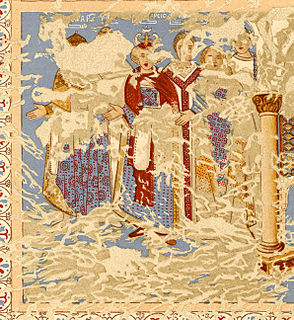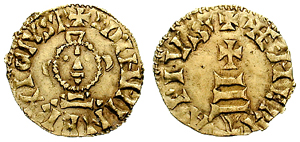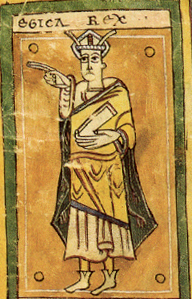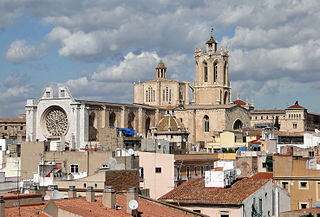
The First Council of the Lateran was the 9th ecumenical council recognized by the Catholic Church. It was convoked by Pope Callixtus II in December 1122, immediately after the Concordat of Worms. The council sought to bring an end to the practice of the conferring of ecclesiastical benefices by people who were laymen, free the election of bishops and abbots from secular influence, clarify the separation of spiritual and temporal affairs, re-establish the principle that spiritual authority resides solely in the Church and abolish the claim of the emperors to influence papal elections.

Toledo is a city and municipality of Spain, capital of the province of Toledo and the de jure seat of the government and parliament of the autonomous community of Castilla–La Mancha. Toledo was declared a World Heritage Site by UNESCO in 1986 for its extensive monumental and cultural heritage.

Reccared I was Visigothic King of Hispania and Septimania. His reign marked a climactic shift in history, with the king's renunciation of Arianism in favour of Catholicism in 587.

Roderic was the Visigothic king in Hispania between 710 and 711. He is well-known as "the last king of the Goths". He is actually an extremely obscure figure about whom little can be said with certainty. He was the last Goth to rule from Toledo, but not the last Gothic king, a distinction which belongs to Ardo.

Wamba was the king of the Visigoths from 672 to 680. During his reign, the Visigothic kingdom encompassed all of Hispania and part of southern Gaul known as Septimania.

Erwig was a king of the Visigoths in Hispania (680–687).

Wittiza was the Visigothic King of Hispania from 694 until his death, co-ruling with his father, Egica, until 702 or 703.

Egica, Ergica, or Egicca, was the Visigoth King of Hispania and Septimania from 687 until his death. He was the son of Ariberga and the brother-in-law of Wamba.

Julian of Toledo (642–690) was born in Toledo, Hispania. He was well educated at the cathedral school, was a monk and later abbot at Agali, a spiritual student of Saint Eugene II, and archbishop of Toledo. He was the first bishop to have primacy over the entire Iberian Peninsula—a position he has been accused of securing by being complicit in 680 in the supposed poisoning of Wamba, king of the Visigoths—and he helped centralize the Iberian Church in Toledo. His elevation to the position of primate of the Visigothic church was a source of great unhappiness among the kingdom's clergy. And his views regarding the doctrine of the Trinity proved distressing to the Vatican.
Oppas, also spelled Oppa, was a member of the Visigothic elite in the city of Toledo on the eve of the Muslim conquest of Hispania. He was a son of Egica and therefore a brother or half-brother of Wittiza.
The Seventeenth Council of Toledo first met on 9 November 694 under King Egica. It was the king's third council and primarily directed, as was the Sixteenth, against the Jews, for whom Egica seems to have had a profound distrust and dislike.
The Sixteenth Council of Toledo first met on 25 April 693, the second of Egica's three councils.
The Thirteenth Council of Toledo, called by Visigothic king Erwig, opened in Toledo, Spain, on 4 November 683. 77 bishops, 5 abbots, 3 church dignitaries, and 27 palatine functionaries participated.
Sisbert or Sisebert was the metropolitan archbishop of Toledo from 690 to 693 as successor to the famous Julian.
The Twelfth Council of Toledo, held in Toledo, Spain, was initiated on 9 January 681 by the Visigothic King Erwig, who was elected king in 680. One of its first actions was to release the population from the laws of Wamba and recognise Erwig, anathematising all who opposed him.

The Archdiocese of Tarragona is a Roman Catholic ecclesiastical territory located in north-eastern Spain, in the province of Tarragona, part of the autonomous community of Catalonia. The archdiocese heads the ecclesiastical province of Tarragona, having Metropolitan authority over the suffragan dioceses of Girona, Lleida, Solsona, Tortosa, Urgell and Vic.
The Sixth Council of Toledo was the second council convoked by King Chintila and opened on 9 January 638 in the church of St. Leocadia in Toledo. It was attended by fifty three bishops, including those from Narbonensis who had not participated in the prior council for political reasons. The council was thus a reunion of the whole church of Spain. Its primary purpose was to reaffirm the decrees of the Fifth Council of 636 and to restore internal peace.
The Council of London in 1075 was a council of the Catholic Church in England held by the new Norman archbishop of Canterbury Lanfranc five years after his installation. Other attendees included Gisa, Bishop of Wells and William the Norman. The Council of London produced several decrees, these were known as the "Canons of the Council of London AD 1075".
The legal history of the Catholic Church is the history of the oldest continuously functioning legal system in the West, much later than Roman law but predating the evolution of modern European civil law traditions. The history of Latin canon law can be divided into four periods: the jus antiquum, the jus novum, the jus novissimum and the Code of Canon Law. In relation to the Code, history can be divided into the jus vetus and the jus novum. Eastern canon law developed separately.

Toledo is the repository of more than 2000 years of history. Successively a Roman municipium, the capital of the Visigothic Kingdom, a fortress of the Emirate of Cordoba, an outpost of the Christian Kingdom, and in the 16th century, the temporary seat of supreme power under Charles V. Its many works of art and architecture are the product of three major religions – Judaism, Christianity and Islam.